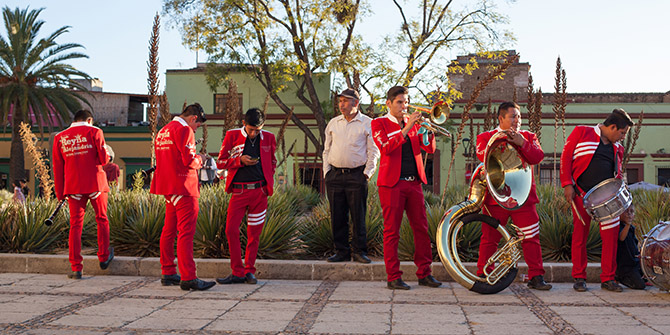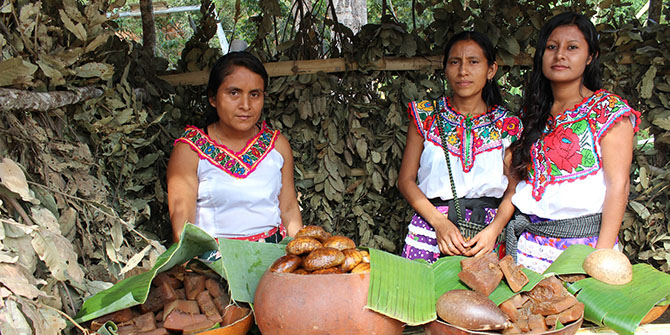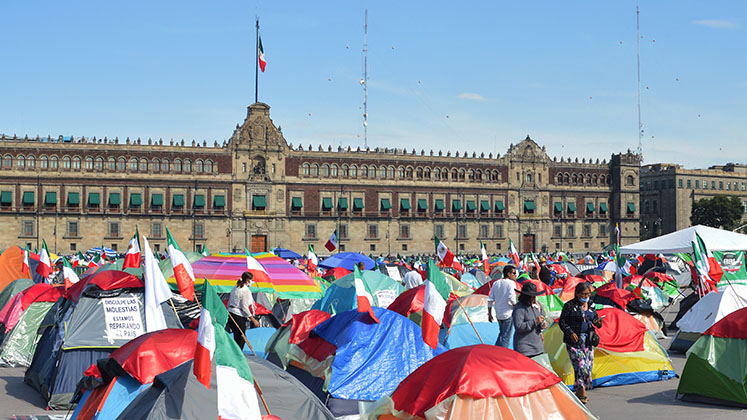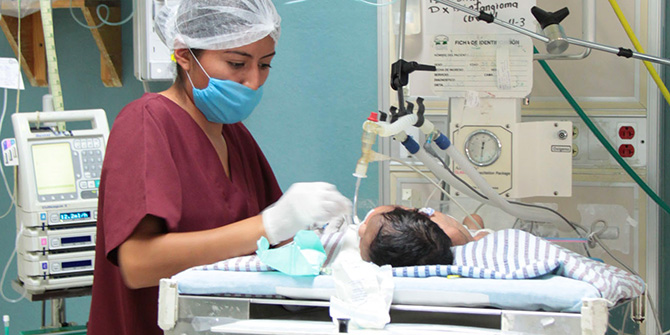
Having a southern president for the first time since 1911 could see states like Oaxaca, Chiapas, and Guerrero receive the attention they need instead of being dismissed as a burden on national development. But without the right policies to generate the right outcomes, Mexico’s poor and deprived south could be left waiting once more for a positive change in its fortunes, writes Rodrigo Aguilera.
Southern Mexico has long been emblematic of the country’s developmental divide. As a region, it has the highest poverty rates, the most severe infrastructure deficiencies, and the lowest educational outcomes in the country. Of Mexico’s 100 largest firms, not a single one is headquartered in the south. And since the reign of Oaxacan strongman Porfirio Díaz ended in 1911, none of Mexico’s presidents has come from a southern state.

There is no consensus on what constitutes “the south”, aside from the fact that three states usually find themselves at the bottom of any socio-economic ranking: Chiapas, Guerrero, and Oaxaca. A few neighbouring states are sometimes lumped into the same category as well, to the extent that anything broadly to the south or southeast of Mexico City can be seen as the south.
The inclusion of the Yucatán Peninsula – which hosts the states of Campeche, Quintana Roo, and Yucatán – is not universally accepted, however, as with neighbouring states like Michoacán, Puebla, and Tabasco.
Yet the latter is the home state of the President Andrés Manuel López Obrador, who frequently refers to himself as a sureño, or “southerner”. On a recent visit to Tabasco, he remarked:
“This is my state too, this is my land, I was born in Tepetitán and that is why we will address the southeast. It’s been 70 years since there was a president from the south.”
The state of development in the south
By every metric, the three states universally recognised as the south – Chiapas, Guerrero, and Oaxaca (henceforth “South-3”) – have the lowest levels of socio-economic development in Mexico. Even by Latin American standards, not to mention those of the OECD, the region’s level of development is appalling.
According to official 2016 poverty data from CONEVAL, 71.5 per cent of the population of the South-3 region lived in poverty, which is well above the national rate of 43.6 per cent. Over a quarter of the population (26.3%) was in extreme poverty, more than three times the national average of 7.6 per cent. Despite representing just over a tenth of the country’s population, these three states accounted for nearly a third of the country’s total number of extreme poor. And at the local level, the list of the country’s poorest 15 municipalities was overwhelmingly dominated by Chiapas and Oaxaca.
The definition of the south can be expanded to include three more states with socio-economic indicators that also fall well below national averages: Michoacán, Puebla, and Veracruz. All three are contiguous with the South-3 states and have highly deprived geographic regions stretching out of the territory of the South-3. The obvious examples are La Mixteca (Puebla/Guerrero/Oaxaca) and Tierra Caliente (Michoacán/Guerrero), with the latter having become a hotbed of drug-cartel activity and anti-cartel militias in recent years.

In the expanded six-state aggregation South-6 (illustrated above) we find not only a quarter of the country’s total population, but also 40 per cent of Mexico’s poor, and almost 60 per cent of its extreme poor. More worrying is the fact that in these states the likelihood of being extreme poor is much higher if you’re already in poverty. In other words, higher levels of extreme poverty are not explained merely by the higher headline poverty rate.
Why then is Yucatán – here referring to the three states on the peninsula – not included in this expanded definition of the south? Because contrary to popular perception, the peninsula itself is not doing that badly.
Both poverty and extreme poverty rates are lower than the national average, the latter being just 5.6 per cent across the three states. According to the latest state-level calculation of the UN’s Human Development Index (2012), Yucatán’s HDI was 0.747. This is in line with the national average, whereas the South-3 has a score of just 0.676. Excluding Campeche, whose GDP is grossly overstated due to Pemex oil revenues, the remaining two states of the peninsula have levels of GDP per capita that are not much worse than the national average.
Why is the south worse off?
One of the most common explanations of why the south is poorer is its larger indigenous population. And indeed there are a disproportionate number of indigenous people in the South-3 region: around a quarter of the population speaks an indigenous language, compared to just 6.5 per cent nationally. That said, Yucatán has similarly high levels of 21.3 per cent.
A key distinction between indigenous people in these two regions is the divergence in respective levels of monolingualism. A staggering 22.1 per cent of indigenous speakers in the South-3 do not speak Spanish, compared to just 4 per cent in Yucatán.
Even among indigenous speakers, there is a considerable difference in homogeneity. The main indigenous language in Yucatán is the Yucatec branch of Mayan. In contrast, there are five main indigenous language groups in Chiapas, of which the main two, Tzotzil and Tzeltal, are mutually unintelligible despite both stemming from Mayan. Oaxaca has no less than 16 main language groups. While positive from a perspective of cultural diversity, this linguistic heterogeneity discourages the region’s poor from uniting politically to act in the collective interest.

Topography is another factor that explains the south’s low levels of development. Most of the states in the South-6 are traversed by any one of three major mountain ranges, which further isolates small communities in a region that is largely rural: nearly half of the population in the South-3 (and almost 40% in the South-6) live in towns of less than 2,500 people. This greatly increases the cost of connecting these communities to wider national and global markets. Unsurprisingly, the region has struggled to promote itself economically: the South-3 accounted for just 2.5 per cent of cumulative foreign direct investment into Mexico during the period 1999 to 2017.
Finally, while bad state governors have been a hallmark of Mexico’s post-2000 democratic era, the South-6 region has had a disproportionate amount of them. Since a precursor of this piece was published in 2015, Javier Duarte of Veracruz has been incarcerated after fleeing the country to escape corruption charges; Rafael Moreno Valle of Puebla was accused of repression against his political opponents and rigging the 2018 state election in favour of his wife (both died in a helicopter crash early this year); and Manuel Velasco of Chiapas ended his controversial term in 2018 as the most unpopular governor in the country.
Rescuing the south?
As Mexico’s first southern president in decades, and one that has placed his socio-economic agenda front and centre, we might expect the south to have a lot to gain under López Obrador. Unfortunately, his vision for the south does not appear to be fully grounded in the region’s economic reality.
First, even though AMLO’s administration has unveiled a variety of grandiose infrastructure projects, they are concentrated in the parts of the south that least needs them, such as Yucatán. The proposed Maya Train, a railway that will loop across the peninsula, is designed to boost an already booming tourism industry. Even as a non-tourism project, it will help connect a region that is already highly urbanised (just 17.7% rural) and mostly flat.
It is hard not to conclude that more people would be lifted from poverty in Oaxaca and Chiapas if an equivalent amount of investment ($6-8 USD billion) were to be spent on rural roads, healthcare, educational facilities, and boosting cash transfers.
Another ambitious regional project is the $8 billion refinery in Tabasco, built purely to reduce Mexico’s dependency on gasoline imports from the US despite Mexico enjoying a trade surplus overall. As with the Maya Train, there are major environmental concerns surrounding the project, whereas there is much doubt the project’s long-term productive impact and overall benefit to an energy sector that offers little trickle-down. Oil-rich Tabasco’s socio-economic indicators are similar to those of the South-6 despite the fact that it has none of the geographical and demographic issues that the other six states face (hence its exclusion from “the south” here).
While these projects are likely to go further than the libertarian-inspired “special economic zones” proposed by the Peña Nieto administration, they are in many ways a microcosm of the problems undermining López Obrador’s economic policymaking: that is, good intentions are combined with misallocation of resources and minimal consultation with exporters or stakeholders. Yet, given Mexico’s weak revenue-collecting capacity, it is vital that public (and private) spending be targeted in ways that would maximise its impact on poverty alleviation.
Having a southern president once again could mean that the south will finally receive the attention it needs, rather than being seen merely as a “burden” on the country’s development. But without the right policies to generate the right outcomes, Mexico’s poorest and most deprived region will be left waiting once more for its fortunes to change for the better.
Notes:
• The views expressed here are of the authors rather than the Centre or LSE
• This article builds on a previous piece published by The Huffington Post in 2015
• Please read our Comments Policy before commenting





Very informative, analytical and well-stated. I have a few ideas and would appreciate your reaction.